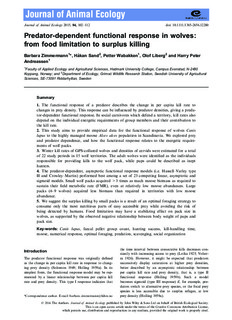Predator-dependent functional response in wolves: from food limitation to surplus killing
Journal article, Peer reviewed
Permanent lenke
http://hdl.handle.net/11250/277796Utgivelsesdato
2014Metadata
Vis full innførselSamlinger
Originalversjon
Zimmermann, B., Sand, H., Wabakken, P., Liberg, O., Andreassen, H. P. (2015), Predator-dependent functional response in wolves: from food limitation to surplus killing. Journal of Animal Ecology, 84: 102–112. doi: 10.1111/1365-2656.12280 10.1111/1365-2656.12280Sammendrag
The functional response of a predator describes the change in per capita kill rate to changes in prey density. This response can be influenced by predator densities, giving a predator-dependent functional response. In social carnivores which defend a territory, kill rates also depend on the individual energetic requirements of group members and their contribution to the kill rate.
This study aims to provide empirical data for the functional response of wolves Canis lupus to the highly managed moose Alces alces population in Scandinavia. We explored prey and predator dependence, and how the functional response relates to the energetic requirements of wolf packs.
Winter kill rates of GPS-collared wolves and densities of cervids were estimated for a total of 22 study periods in 15 wolf territories. The adult wolves were identified as the individuals responsible for providing kills to the wolf pack, while pups could be described as inept hunters.
The predator-dependent, asymptotic functional response models (i.e. Hassell–Varley type II and Crowley–Martin) performed best among a set of 23 competing linear, asymptotic and sigmoid models. Small wolf packs acquired >3 times as much moose biomass as required to sustain their field metabolic rate (FMR), even at relatively low moose abundances. Large packs (6–9 wolves) acquired less biomass than required in territories with low moose abundance.
We suggest the surplus killing by small packs is a result of an optimal foraging strategy to consume only the most nutritious parts of easy accessible prey while avoiding the risk of being detected by humans. Food limitation may have a stabilizing effect on pack size in wolves, as supported by the observed negative relationship between body weight of pups and pack size.
